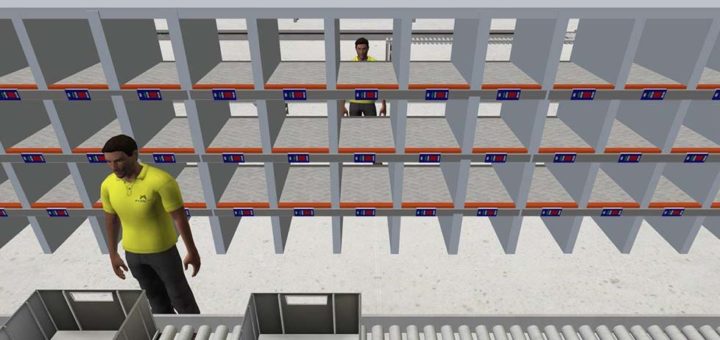Put Walls for Today’s Warehouses

Warehouses, distribution centers, retailers, and other order fulfillment operations leverage put wall technology. They provide a simple and affordable way for businesses to combine orders, helping improve efficiency in your systems.
Put Walls
Put walls are a simple way to organize orders as part of the order fulfillment process. Workers in different parts of the warehouse pick and fulfill orders. After picking the items, the workers take the partial orders to the put wall for grouping. The worker places the picked partial orders in a specific cell on the put wall.
Once all the operators deliver their portion of the order to the cell, the order is complete. An operator places the completed order in a carton or case and it is ready for shipping. The cell that took the completed order is now available for the next order.
Paperless, scalable, and modular, put walls allow for improved order accuracy, shorter total order cycle time, and—because they empower you to do more with less labor—increased profitability. They can be particularly beneficial to operations dealing with SKU proliferation, more varied order profiles, and high throughput/velocity requirements.
Download our Guide to Order Fulfillment Strategies

These systems are suitable for smaller warehouses or those with moderate throughput demands. Their cost-effectiveness and simplicity make them ideal for businesses with limited resources. In scenarios with stable orders and a manageable warehouse size, manual put wall systems offer a good solution. Small businesses and startups may find these systems acceptable for their warehousing operations.
Put walls are particularly popular in e-commerce operations which handle small average orders. Workers can e-commerce multiple orders to a single tote, but then split them into individual orders at the wall. They can be leveraged as a part of both manual and automated picking systems.
Manual put wall systems may face speed and accuracy issues with increasing warehouse complexity. Advanced and automated put wall systems are paperless, scalable, and modular and have greater accuracy and shorter order cycle time.
Optimizing Put Walls
Optimize the wave size to match the put wall.
Some operations find themselves in trouble because of their wave size. Waves need to take into consideration the number of put wall cells. You may end up with more orders that you can put away because the put wall compartments are full.
While this may seem obvious, it speaks to the importance of having the right WES directing your system. A Warehouse Execution System (WES) can ensure that the wave size matches the put wall cell availability. By matching the number of available compartments, you can always prevent the potential for backlog and streamline your workflows.
Leverage the different put wall technologies available to you.
Advanced technologies can increase the productivity and accuracy of your workers. Put assist technologies work by guiding the picker to the specific compartments or cubbies. These avoid confusion and increase accuracy. They can also reduce order fulfillment time on every order.
Put-to-light and put-to-voice are two time-tested put technologies. Augmented vision is emerging as another powerful option:
Put-to-Light (PTL)
A put-to-light system uses lights to give the worker a visual cue. This visual cue indicates which compartments should receive product and which orders are ready for packing. Put-to-light technology is common with put wall applications. However, installing the lights with wiring can be expensive and time-consuming to implement.
Put-to-Voice
A put-to-voice system uses auditory cues and voice instructions to direct the worker to the correct compartment. The headset guides the worker, keeping their eyes up so they can move quickly between tasks.
This technology is particularly helpful in operations which require speed. Put-to-Voice is fast to implement in comparison to put-to-light systems. It is still not common with put wall applications.
Augmented Vision
While a relatively new technology, augmented vision brings a number of powerful benefits to put wall applications. It supports both the putting and picking activities associated with the wall. Augmented vision combines the hands-free benefit of pick-to-voice with the efficiency-boosting visual cues of pick-to-light. The technology is often a much less expensive option as there is no light and wiring installation.
Augmented vision technology can allow an operation to generate additional storage locations during peak periods. These temporary positions can be on a section of shelving, rolling rack, a table top—any location with a QR code.
Automated Put Walls
Automated put walls are like organized shelves that robots fill up with items in distribution centers. They’re becoming more popular because they make picking and packing orders faster and more accurate. Warehouse management systems (WMS) and warehouse execution systems (WES) can leverage these systems quite well.
With robots doing the repetitive tasks, workers can focus on other critical tasks, and increase accuracy and speed up deliveries. They save space by efficiently storing items for shipping. Learn more about automated put wall technology here.
Analyzing Your Put Wall Options
Consider the various ways that you can optimize to get even greater value. Whether you have one in your facility for years or your adding a new one to your operation. Review your operation’s workflows and advanced put wall technologies to help you maximize efficiency and accuracy.
Are you unsure of your best path forward in optimizing your put wall application? Do you need help determining whether put-to-light, put-to-voice, augmented vision, or automation is right for you?
Do you simply want another set of eyes to help guide your decision? Speaking with a trusted systems integrator can be an excellent place to start. Click here for a no-obligation consultation.













